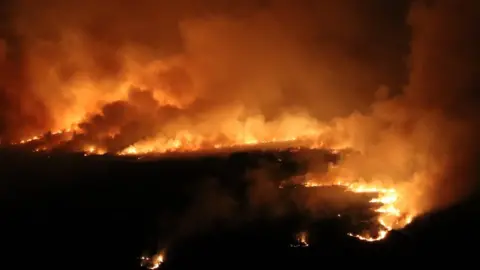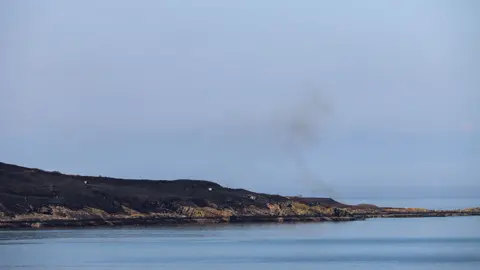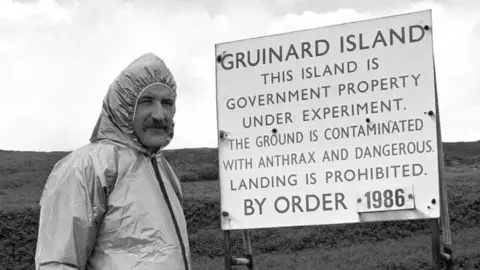Gruinard Island: Fire on island used for Anthrax experiments
An uninhabited Scottish island where government scientists once conducted experiments with Anthrax has been hit by a fire.
People who saw the fire on Gruinard Island from the mainland described the scene as "apocalyptic".
They said the uninhabited island off Scotland's north-west coast was ablaze from "one end to the other" on Saturday evening.
The island was used for germ warfare experiments during World War Two.
It was declared free of Anthrax by the Ministry of Defence in April 1990.
 Nessie Gearing
Nessie GearingKate Gearing and her daughter Nessie were at their home in Aultbea when they saw a glow in the sky, around 20:30 on Saturday.
They could smell the smoke in the air from their house which is about five miles from the island.
They got into the car to investigate, and drove along the coast until they saw the fire, which they said you couldn't miss.
Nessie took pictures from the area around Gruinard beach.
The 25-year-old described the scene as "apocalyptic," and said it looked like "hell fire".
"There was a string of flames around the whole circumference of the island," she said.
Kate said the island off the north west coast was lit up by flames from one end of the island to the other.
The most distressing thing about the scene, Kate said, was the noise of birds, which she thinks were nesting on the island.
"We could hear birds crying, screaming, and then suddenly there was silence - but the flames went on, it was awful."
She said thankfully the island is far away enough from shore not to be a danger to the mainland.
The pair returned on Sunday, and said there were no obvious flames by the afternoon. However, there was still some smoke hanging in the air.
Kate, a retired GP, said: "The island is pretty black now. There's just a few trees left standing, along the shoreline."
"I'm just hoping there aren't any anthrax spores left around anywhere," she added.
 Nessie Gearing
Nessie GearingThe Scottish Fire and Rescue Service said the island did not fall under its remit because it is uninhabited.
Earlier this week it issued a warning that the risk of wildfires was "very high" in central, southern and north-east Scotland.
It urged people to to think twice about using naked flames outdoors.
How did Gruinard Island come to be contaminated with Anthrax?
 PA Media
PA MediaAnthrax is a lethal bacteria, especially when inhaled, and it proves fatal in almost all cases, even with medical treatment.
Gruinard had long been uninhabited when, with World War Two on a knife edge, the government tasked scientists with finding a way of harnessing anthrax as a weapon - fearing the Nazis had developed a biological bomb.
They had to find a testing site that was remote, uninhabited and isolated but accessible from the mainland.
Rumours began to spread on the mainland when sheep, cows and horses began dying strange deaths.
The facts about what happened remained a mystery until the declassification of an MoD film 50 years later.
It showed sheep being put in exposure crates facing the anthrax cloud.
The film shows a small blast set off by remote control and then white powder moving on the wind. Within days all the sheep were dead.
The experiment was deemed a success and the scientists returned to Porton Down - but the anthrax remained.
In an attempt to rid the island of anthrax spores, Porton Down instructed the heather be set on fire.
It remained off limits and it was not until 24 years after the experiment that the warning signs even mentioned Anthrax.
Porton Down experts checked the soil but the anthrax spores were "surprisingly resistant to degradation".
In 1986, Gruinard was again a hive of activity as teams of scientists, vaccinated against anthrax and dressed in protective clothing, prepared to return the island to its natural state.
They sprayed the soil with seawater and formaldehyde and it was again tested at Porton Down.
Finally, on 24 April 1990, the MoD declared Gruinard anthrax free.
